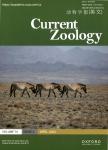Functional diversity of small-mammal postcrania is linked to both substrate preference and body size
作者机构:Department of BiologyLife Sciences BuildingUniversity of WashingtonSeattleWA 98195USA
出 版 物:《Current Zoology》 (动物学报(英文版))
年 卷 期:2020年第66卷第5期
页 面:539-553页
核心收录:
学科分类:0710[理学-生物学] 07[理学] 071002[理学-动物学]
基 金:the National Science Foundation Graduate Research Fellowship,UW Biology Burke Museum the National Science Foundation Postdoctoral Research Fellowship in Biology(DBI-1812126).
主 题:adaptive landscapes ecomorphology morphometries phenotypic diversity phylogenetic comparative methods trait partitioning
摘 要:Selective pressures favor morphologies that are adapted to distinct ecologies,resulting in trait partition!ng among ecomorphotypes.However,the effects of these selective pressures vary across taxa,especially because morphology is also influenced by factors such as phylogeny,body size,and functional trade-offs.In this study,we examine how these factors impact functional diversification in mammals.It has been proposed that trait partitioning among mammalian ecomorphotypes is less pronoun ced at small body sizes due to biomecha nical,energetic,and environ mental factors that favor ageneralistbody plan,whereas larger taxa exhibit more substantial functional adaptations.We title this the Diverge nee Hypothesis(DH)because it predicts greater morphological divergence among ecomorphotypes at larger body sizes.We test DH by using phylogenetic comparative methods to examine the postcranial skeletons of 129 species of taxonomically diverse,small-tomedium-sized(15 kg)mammals,which we categorize as eithertree-dwellersorground-dwellers.In some analyses,the morphologies of ground-dwellers and tree-dwellers suggest greater between-group differentiation at larger sizes,providing some evidence for DH.However,this trend is n either particularly strong nor supported by all an alyses.In stead,a more pronoun ced patter n emerges that is distinct from the predictions of DH:within-group phenotypic disparity increases with body size in both ground-dwellers and tree-dwellers,driven by morphological outliers amongmedium -sized mammals.Thus,evolutionary increases in body size are more closely linked to increases in within-locomotor-group disparity tha n to in creases in betwee n-group disparity.We discuss biomechanical and ecological factors that may drive these evolutionary patter ns,and we emphasize the significant evolutionary influences of ecology and body size on phenotypic diversity.



